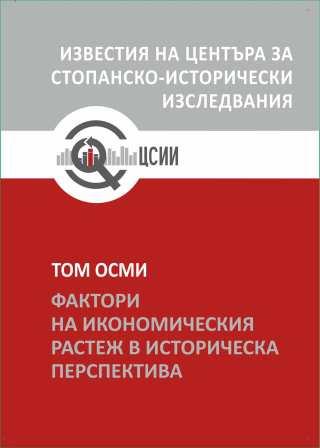ЗЕМЯТА КАТО ФАКТОР ЗА ИКОНОМИЧЕСКИЯ РАСТЕЖ. ПРЕПЛЕТЕНИ ТРАЕКТОРИИ НА ЕДРОТО ЗЕМЕВЛАДЕНИЕ В БЪЛГАРИЯ ОТ XIX И XX ВЕК
LAND AS A FACTOR FOR ECONOMIC GROWTH. INTERTWINED TRAJECTORIES OF LARGE-SCALE AGRICULTURE IN BULGARIA IN THE 19TH AND 20TH CENTURIES
Author(s): Nikolay Todorov, Petar DobrevSubject(s): History, Economy, National Economy, Business Economy / Management, Agriculture, Economic history, History of ideas, Social history, Modern Age, Special Historiographies:, Human Resources in Economy, Socio-Economic Research
Published by: Център за стопанско-исторически изследвания
Keywords: çiftliks; Ottoman Empire; Bulgaria; Burgas; Dobrudja; Vidin; Agrarian question; large-scale agriculture
Summary/Abstract: Both Bulgarian and Western historiography have so far mostly ignored the capitalist estates in Bulgaria (the so-called çiftliks) in the 19th and 20th centuries. And while çiftliks were indeed relatively few in number, recent research shows their undeniable influence and persistence. Our work in the Bulgarian and Ottoman archives complements this trend, and in this article we examine some of the areas of successful large-scale landholding and hence the question of land as a factor in economic growth. By analysing the regions of Vidin, Burgas and Dobrudja, we try to answer the question of why çiftliks developed successfully only in certain areas of the country and, consequently, what determined their failure in other, otherwise fertile regions. In our work, we look for the interplay of historical, demographic, geographical and economic factors that make land a profitable economic investment in some places and make agrarian capitalism impossible elsewhere. Our reasoned assumption is that the Ottoman context is crucial for the development of çiftliks after 1878: the different forms of land use in the regions we examine in the late nineteenth century predetermined economic development after 1878 as well. For this purpose, we use Ottoman records of the temettüat defterleri type, which particularly fully show the state of agriculture in the 1840s, as the starting point of our study. We focus mainly on three zones - Vidin, Dobrudja and Burgas - the choice being dictated by the fact that in all three zones there were favourable conditions for large-scale agriculture, but only the two seaside districts developed such agriculture after the Bulgarian liberation, while in Vidin it was completely absent. This is determined by the fact that in the first two zones, during Ottoman times, the peasants owned the land, while in Vidin they were only tenants. It is interesting also to note that in Burgas there was a predominance of Muslim-owned çiftliks which after the Liberation of Bulgaria were bought or taken over by Christians, while in Dobrudja state protections helped the development of Christian-owned çiftliks even before 1878. With quantitative data we also show that in Dobrudja and Burgas çiftliks were economically viable and market-oriented agrarian structures, which in addition influenced the overall economic growth.
Journal: Известия на Центъра за стопанско-исторически изследвания
- Issue Year: VIII/2023
- Issue No: 1
- Page Range: 93-104
- Page Count: 12
- Language: Bulgarian

